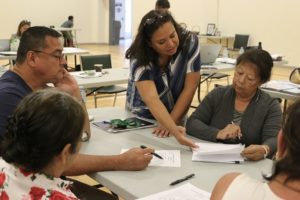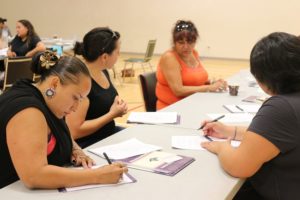Child Well-Being Working Group meet to advance implementation of Child Well-Being Law

By Laura Barrios
ALGONQUINS OF PIKWAKANAGAN—The Child Well-Being Working Group gathered in the Algonquins of Pikwakanagan First Nation on July 9-10 to receive presentations from various keynote speakers and provide input to advance the implementation of the Anishinabek Nation Child Well-Being Law.
The Anishinabek Nation Child Well-Being Law is the law approved by the Anishinabek Chiefs-in-Assembly by Grand Council Resolution and being adopted by the Anishinabek First Nations in accordance with the First Nation law-making process.
“We have 11 out of 40 First Nations that have ratified or approved the implementation of the Child Well-Being Law,” shared Tracey O’Donnell, Child Well-Being Law legal counsel. “Those communities are moving forward. Meetings with Chiefs and Councils and citizens will need to continue in the other First Nations. Each First Nation has to decide for itself whether it will enact the Child Well-Being Law.”
In accordance with the law, the Child Well-Being System will be established pursuant to the Anishinabek Nation Child Well-Being Law to support Anishinabek child and youth well-being and family unity.
“First Nations implementing and adhering to the Child Well-Being Law are exercising their inherent jurisdiction over the well-being of their children, regardless of residency,” explained O’Donnell. “The law will ensure the safety and well-being of their children and youth, families and communities. It acknowledges, respects and supports the primary role of parents/guardians, families and communities in safeguarding and promoting the well-being of the children and youth. It provides for the protection and care of children and youth in circumstances where their parents or guardians have not given or are unlikely or unable to give that protection and care. The law also ensures that traditions, culture, values and language are maintained. Lastly, the law ensures that adoptions only occur on the approval of the parent or guardian and the First Nation the child and youth and his or her parents or guardians belong to. Additionally, the law will also establish the legislative framework for the structure of the Anishinabek Nation Child Well-Being Coordinating body; community agreements; and community standards.”
The 67 participants and members of the working group are encouraged to see that things are moving forward so well and so quickly.
“With Ontario, the Anishinabek Nation negotiated and signed a protocol agreement and a relationship agreement in less than nine months. The Anishinabek Nation also negotiated a draft collaboration agreement,” noted O’Donnell.
 The working group, which is comprised of current or retired Social Workers, Directors of Social departments, citizens from Anishinabek First Nations and agency representatives, reviewed various strategic priorities. These priorities, which also included break-out sessions and presentations, are: Establishing a Children’s Bill of Rights, developing a new relationship with Ontario, securing recognition of First Nation jurisdiction and funding from Canada, establishing and implementing a communications strategy.
The working group, which is comprised of current or retired Social Workers, Directors of Social departments, citizens from Anishinabek First Nations and agency representatives, reviewed various strategic priorities. These priorities, which also included break-out sessions and presentations, are: Establishing a Children’s Bill of Rights, developing a new relationship with Ontario, securing recognition of First Nation jurisdiction and funding from Canada, establishing and implementing a communications strategy.
“The Child Well-Being Working group keeps growing and it’s amazing and wonderful to see how many people have concerns and interest in making the future better for the kids,” expressed Hilda Tennisco, citizen of Algonquins of Pikwakanagan and member of the working group. “It’s nice to see everything that we’re doing and where we’re at now, what needs to get done, and what we need to work towards.”
Participants also received presentations on Alternative Dispute Resolution, Anishinabek Nation Grandparents Committee, Community Agreement and Community Standards, Action Plan for Anishinabek Children and Youth, Collaboration with the Kinoomaadzawin Education Body, and Elder Reflections.


